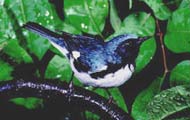Older stories on Resources News
Links to general resource, environmental sites
Links to non-profit environmental/resource groups
Links to environmental/resource news sources
E-mail Resources News
Warbler's Winter, Summer Ranges Linked
Research into the migration habits of birds has been conducted for many years - but there is still much to learn. More information about one eastern North America species, the black-throated blue warbler, has recently been added to the body of scientific knowledge by researchers from Dartmouth College, Stanford University and the Smithsonian's National Museum of Natural History. The findings of their study link this species' summer breeding grounds in eastern North America with its wintering sites in the Caribbean, and they help to identify where these migratory birds are most vulnerable.
The research was conducted by analyzing stable isotopes in feathers. The research team determined that these songbirds segregate in their Caribbean wintering grounds according to where they live and breed during the summer months in North America.
"Because these animals are distributed widely and travel long distances each year, it has been difficult to track and study their migratory movements with conventional techniques, such as bird banding or radiotelemetry," said Dustin Rubenstein, a 1999 Dartmouth graduate and currently a Ph.D. student at Cornell University. "We used the relatively new technique involving measurements of stable isotopes to learn where specific groups of breeding birds spend their winter. Ultimately, we hoped the results might help us understand why some populations were declining."
The study shows that black-throated blue warblers breeding during the summer months in New Brunswick to northern Michigan, New York and New England spend the winter mainly in the western Caribbean islands of Cuba and Jamaica. Warblers from the Appalachian Mountains from West Virginia to Georgia winter mostly in Puerto Rico and Hispaniola.
These locales were determined by analyzing isotopes contained in the birds' feathers. For these warblers, feathers grown during or just after the breeding season contain carbon and hydrogen isotope signatures that reflect a bird's diet and that of the local breeding environment. Because the isotopes vary naturally among geographic areas in North America and because the birds only molt once a year, analyses of isotopes in feathers collected from wintering birds can reveal the location of their breeding sites.
